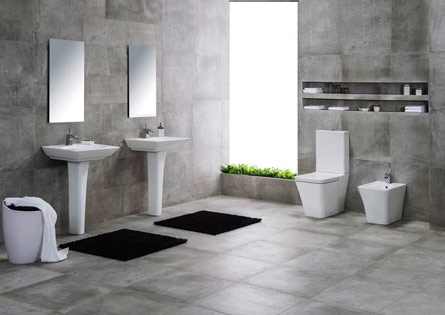
In making the body composition of several types of Wall tiles, Floor tiles, Porcelain tiles, Sanitary ware, china & earthenware and also in the preparation of glazes and enamel.
For ceramic bodies, the main vitrifying (fluxing) agent is feldspar. The majority of white ware bodies contain good proportions of feldspar. In the ceramic industry, the flux is defined as the portion of the body which develops glass phase. This is provided mostly by feldspar. The amount of flux in a ceramic body should be only in such a proportion as to develop the desired amount of vitrification. If excess of flux is added, the fired body becomes very glassy and consequently brittle.
In the preparation of glazes the fine powder of feldspar is mixed with silica powder and a thin slurry is made. The fired up goods are dipped into the slurry and fired again. This imparts glaze to the surface. Some other ingredients are also added to the slurry to impart glaze and lustre. Each pottery factory has its own technique of preparing slurry which is regarded as a trade secret. Fusiblity is very important. The Glazes high in feldspar (35% or more) are likely to produce crazing problems. 'Flux saturated' glazes with more than 50% feldspar may be unbalanced and lack adequate glass former or alumina. The High melting Point is 1250C with M Specific.
Soda Feldspar is generally a clean white mineral which sources sodium, alumina and silica along with some potassium and calcium. Albite mineral from which soda feldspar is derived is often tends to be white in appearance compared with the pinkish hue of orthoclase mineral from which potash feldspar is ground. It begins melting around 800C.
In many cases soda and potash feldspar are interchangeable in glaze recipes. However, some differences will be apparent. For example, slightly different color responses will be encountered (i.e. cobalt tends toward purple copper toward blue with soda spar). Sometimes colors will be brighter with soda feldspar. In addition, soda spar has a higher coefficient of expansion and melts earlier and has a shorter range before it begins to volatilize.
Soda feldspar is a clean white mineral with a melting range of 1100-1500'C. Soda and Potash feldspar are interchangeable in glaze recipes but there are some differences between them. Soda feldspar melts better than the potash feldspar. Soda feldspar has a higher coefficient than the potash.
Soda feldspar is a volatile substance and has excellent moisture absorbent capacity due to which this compound melts when it comes in contact with the atmosphere.
It is used for fireproof ceramics, fine ceramics, tableware floor and wall tiles, sanitary ceramics, porcelain and glazes. In the CERAMIC body, silica is the skeletal structure upon which clays and flux components attach. The SiO2 contribution is used to modify thermal expansion, regulate drying and shrinkage, and improve structural integrity and appearance. Quartz powder is also used in ceramic tiles along with feldspar. The powder is available in semi and snow-white color, which has 90%+ whiteness that is considered "A" grade, and is mostly used by table ware manufacturer because of extra whiteness and non-contamination. However in ceramics, huge quantities of quartz powder are used in bodies and glazes. Usually 200, 300 & 325# meshes are used.
China Clay is also called "KAOLINE", it is one of the essential Raw material for Ceramic Industries. China Clay does not swell on adding water & Alumina present in Clay do not form Isomorphous series with any other metallic compound. It is naturally hydrated Aluminum Silicate. It is one of the most abundantly available clay in the Earth's crust. China Clay is the heart of potteries, tiles, ceramics, Glazes and many other industries.
Talc is increasingly being used in the manufacture of artwares, jars, wall and floor tiles. It serves as a non-plastic ceramic material. The addition of talc in suitable proportions in the body of mixtures for porcelain, jars etc. prevents the crazing (cracking) effect on the glazes. The proportion of talc in the ceramic body may go upto 80%. It is valued for its refractoriness and stability, as well as extremely low shrinkage at high temperature. Talc converts into clino-enstatite at about 1300C. Between 800C to 840C, the water molecules are driven off and talc dissociates into enstatite and amorphous silica without undergoing any change in shape, the shrinkage being 0.0005 inch only.
Bentonite is used in pottery, porcelain clay bodies and in glazes. It is highly plastic, sticky clay which is the result of decomposing volcanic ash or rock. In clay bodies, it promotes plasticity. In glazes, it can help raw glaze coats to adhere to bisqueware before firing. Bentonite also helps keep the particles of the liquid glaze batch in suspension. In pottery and porcelain clay bodies additions of only 2% can produce marked improvements in workability and dry strength without much effect on fired color. The use of up to 5% is common, especially where high plasticity is needed in a white burning body.
Calcite (Calcium Carbonate):- Various milled grades of Calcite are used in Ceramic industry for Wall Tile, Floor Tile, Sanitary ware, Glaze & Frit for its High & Low Tension Insulator applications. Calcite provides better bonding and green strength in ceramic glazes.
Calcite containing CaO is the principal flux in medium & high temperature glazes. It reduces the viscosity and co-efficient of thermal expansion. It promotes adherence, stability, hardness and toughness to the glaze when used in a proper concentration. Calcite also whitens the glaze to the greater extent by its bleaching action. It is used as source of lime (CaO) in sanitary ware glazes & floor tile glazes.
Note:- Specifications and chemical analysis can be furnished only when we get to know the grades/applications desired by you.